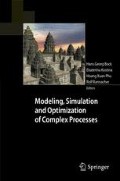Abstract
A commonly used method for the fitting of smooth functions to noisy data sets is the thin-plate spline method. Traditional thin-plate splines use radial basis functions and consequently requires the solution of a dense linear system of equations that grows with the number of data points. We present a method based instead on low order polynomial basis functions with local support defined on finite element grids. An advantage of such an approach is that the resulting system of equations is sparse and its size depends on the number of nodes in the finite element grid.
A potential problem with local basis functions is an inability to fill holes in the data set; by their nature local basis functions are not defined on the whole domain like radial basis functions. Our particular formulation automatically fills any holes in the data.
In this paper we present the discrete thin-plate spline method and explore how Dirichlet boundary conditions affect the way holes are filled in the data set. Theory is developed for general d-dimensional data sets and model problems are presented in 2D and 3D.
Access this chapter
Tax calculation will be finalised at checkout
Purchases are for personal use only
Preview
Unable to display preview. Download preview PDF.
References
R. Arcangéli. Some applications of discrete D m splines. In Mathematical methods in computer aided geometric design (Oslo, 1988), pages 35–44. Academic Press, Boston, MA, 1989.
R. Beatson and L. Greengard. A short course on fast multipole methods. In Wavelets, multilevel methods and elliptic PDEs (Leicester, 1996), Numer. Math. Sci. Comput., pages 1–37. Oxford Univ. Press, New York, 1997.
R. K. Beatson, G. Goodsell, and M. J. D. Powell. On multigrid techniques for thin plate spline interpolation in two dimensions. In The mathematics of numerical analysis (Park City, UT, 1995), volume 32 of Lectures in Appl. Math., pages 77–97. Amer. Math. Soc., Providence, RI, 1996.
J. Duchon. Splines minimizing rotation-invariant. In Lecture Notes in Math, volume 571, pages 85–100. Springer-Verlag, 1977.
M. F. Hutchinson. A stochastic estimator of the trace of the influence matrix for Laplacian smoothing splines. Comm. Statist. Simulation Comput., 19(2):433–450, 1990.
B. Morse, T. S. Yoo, P. Rheingans, D. T. Chen, and K. R Subramanian. Interpolating implicit surfaces from scattered surface data using compactly supported radial basis functions. In Proceedings of International Conference on Shape Modeling and Applications ’01, pages 89–98. IEEE Computer Society Press, May 2001.
T. Ramsay. Spline smoothing over difficult regions. J. R. Stat. Soc. Ser. B Stat. Methodol., 64(2):307–319, 2002.
S. Roberts, M. Hegland, and I. Altas. Approximation of a thin plate spline smoother using continuous piecewise polynomial functions. SIAM J. Numer. Anal., 41(1):208–234, 2003.
R. Sibson and G. Stone. Computation of thin-plate splines. SIAM J. Sci. Statist. Comput., 12(6):1304–1313, 1991.
L. Stals and S. Roberts. Low order smoothers on large data sets with holes. In preparation.
L. Stals and S. Roberts. Verifying convergence rates of discrete thin-plate splines in 3D. In Rob May and A. J. Roberts, editors, Proc. of 12th Computational Techniques and Applications Conference CTAC-2002, volume 46, pages C515–C529, June 2005. [Online] http://anziamj.austms.org.au/V46/CTAC2004/home.html.
J. J. Torrens. Discrete smoothing D m-splines: applications to surface fitting. In Mathematical methods for curves and surfaces, II (Lillehammer, 1997), Innov. Appl. Math., pages 477–484. Vanderbilt Univ. Press, Nashville, TN, 1998.
G. Wahba. Spline models for observational data, volume 59 of CBMS-NSF Regional Conference Series in Applied Mathematics. Society for Industrial and Applied Mathematics (SIAM), Philadelphia, PA, 1990.
Author information
Authors and Affiliations
Editor information
Editors and Affiliations
Rights and permissions
Copyright information
© 2008 Springer-Verlag Berlin Heidelberg
About this paper
Cite this paper
Stals, L., Roberts, S. (2008). Smoothing and Filling Holes with Dirichlet Boundary Conditions. In: Bock, H.G., Kostina, E., Phu, H.X., Rannacher, R. (eds) Modeling, Simulation and Optimization of Complex Processes. Springer, Berlin, Heidelberg. https://doi.org/10.1007/978-3-540-79409-7_38
Download citation
DOI: https://doi.org/10.1007/978-3-540-79409-7_38
Publisher Name: Springer, Berlin, Heidelberg
Print ISBN: 978-3-540-79408-0
Online ISBN: 978-3-540-79409-7
eBook Packages: Mathematics and StatisticsMathematics and Statistics (R0)

